Abstract
A soil depleted of its organic carbon content is typically destabilized, i.e., its capacity to maintain its microstructure intact under various stress conditions weakens, and consequently, landslides and mudflows can be triggered and propagated more easily. In a previous work, we showed with a rheological analysis that the removal of the sole water-soluble organic carbon “destabilized” the slurry very similarly to what occurs with the removal of the vast majority of soil organic carbon. In principle, the water-soluble organic carbon can be dissolved by rainfall, during which water can infiltrate the soil, eventually leaving it either by percolation or evaporation. These two processes are mimicked here with two different soil water wetting procedures. The stability of the treated (wetted) soils is studied with rheological and granulometric experiments. The former run on concentrated suspensions, while the latter run on very diluted ones. Despite this, the results agreed very well, indicating that the two wetting procedures induce the same destabilization of the soil which behaves as the one depleted by the whole water-soluble organic carbon. Our results concluded that a soil destabilized by a wetting procedure, i.e., by a rainfall event, will be more prone to trigger a landslide that will propagate more swiftly and will stop with more difficulties.
1. Introduction
Mud and debris flows are mixtures of soil and water that become mobile and flow down slopes due to gravitational instability [1]. They are serious geological hazards and can cause significant damage in mountainous areas around the world [2,3]. Researchers have conducted numerous experimental [4], numerical, and theoretical investigations [5,6] to characterize these phenomena, aiming to develop effective early warning systems [7] and practical mitigation strategies [8]. Mudflow triggers, evolution, and arrest are influenced by multiple factors acting on different length scales: at the macroscale, the morphological characteristics of the site and its vegetation cover [9]; at the mesoscale, the geopedological and hydraulic properties of the soil [10]; and at the microscale, the soil grain chemical–physical properties [11,12].
Focusing on the microscale, the soil organic carbon (SOC) content is one of the chemical–physical properties that can play a role in mudflow triggering, evolution, and arrest [13]. SOC originates from plants, animals, and microorganisms and their exudates. Since 1948 [14], it has been known that the SOC increases the soil stability, defined by Haynes and Swift [15] as the capacity to resist the slacking and the dispersive actions of water in order to maintain the soil’s porous structure intact. According to the hierarchical theory of aggregation, the soil is composed of macroaggregates that are made of more stable microaggregates of primary particles [16]. SOC is crucial for the stabilization of the soil structure, and, in a simplified interpretation, a transient and temporary SOC binds the microaggregates together, forming the macroaggregate, while a persistent SOC sticks the primary particles together. The transient and temporary SOC has weak interactions with soil grains, is accessible to microbial attack, and is frequently renewed, while persistent SOC develops strong interactions with the soil grains and is protected from degradation [17]. Great attention was devoted in the literature to the dynamics of the water-soluble fraction of SOC, the so-called dissoluble organic carbon (DOC), and its effects on the regulation of nutrient availability, metal mobility, and microbial activities both in soils and water [18]. Moreover, it is known that DOC is the fraction of the transient and temporary SOC that might be easily dissolved by rainfall water [19] and can thus play a role, among other factors, e.g., [20], in the triggering and propagation of shallow landslides.
In 2015, Carotenuto et al. [21] collected soil from a site in south Italy that was involved in a catastrophic landslide to study how the rheology of a soil slurry is affected by the selective removal of different quantities of SOC. In particular, they removed the DOC fraction (about 6% of SOC) by suspending the soil (w:v = 1:10) in an aqueous solution of 10 mM of KCl for 1 min [22], while larger amounts of SOC (up to 89%) were subtracted from the soil by suspending it (w:v = 1:10) in a 5%wt NaOCl aqueous solution [23] for 10 to 120 days. The authors proved that the removal of the sole DOC significantly reduced the viscosity and yield stress of the slurry. They also showed that any further additional removal of SOC induced only minor changes with respect to the removal of the sole DOC fraction.
In this work, we further investigated the possible action of rainfall on the “destabilization” of the soil. To this end, we treated the soil without the aid of any chemical–physical treatment, and instead mimicked the “soil wetting” occurring in natural conditions. In particular, let us consider that the rainwater can infiltrate the soil, draining downwards and flowing away from it, or it can be retained by the soil to successively leave it by evaporation. These two processes may act differently on the eventual removal of DOC. In the first case, a DOC fraction is first dissolved in water and then transported away from the soil. In the second case, it is dissolved in the water retained by the soil, and it remains in the site once the water evaporates. We experimentally mimic these two processes by suspending the soil in water, which is brought away either by drawing it or by evaporation. In the first case, we mimic the rainwater infiltration/drainage process. In the second case, we mimic the infiltration/evaporation process. After these two treatments, the rheology of the soil slurry is characterized, and the results are compared with literature data [21] taken on a slurry made of the same soil investigated here with or without the whole DOC. Moreover, the effect of the two different wetting treatments on the stability of the soil aggregates are investigated by means of an innovative method based on granulometric measurements. We disperse the soil in water and keep the suspension stirred. The evolution of the suspended soil granulometry is followed over time to estimate the dynamics of the soil aggregates’ breakup.
The aim of this paper is to investigate the soil destabilization induced by rainwater infiltration/drainage or the infiltration/evaporation process by means of rheological and granulometric measurements on concentrated and diluted slurries, respectively.
2. Materials and Methods
2.1. Materials: Soil
The soil was the same used in our previous works [21,24], and was collected at a depth of 50–80 cm from the surface within a pedological BW horizon, from a slope affected by a catastrophic landslide in 1999 [25] in the Cervinara site (Avellino, South Italy). The coordinates of the collection site are (41.006760°; 14.646719°) and a map showing its position is reported in Figure 1. The soil was stored in a closed vessel after having dried it. This limits the organic carbon degradation over time; however, the rheology of slurries prepared in these years was monitored to be sure that the soil did not evolve over time.
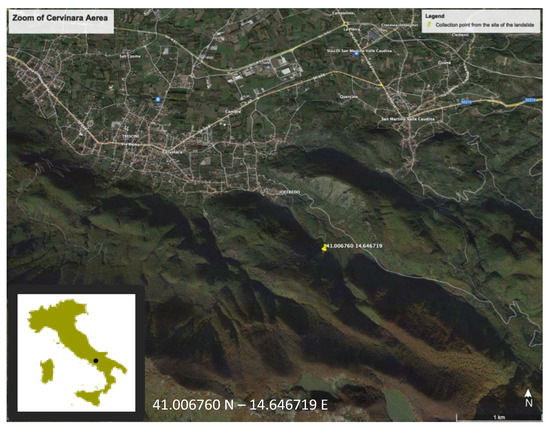
Figure 1.
Satellite map of collection site in Cervinara (Avellino, South Italy). The geographical coordinates are reported. A miniature of Italy is shown to individuate Avellino Area in Campania region.
Cervinara soil granulometry is quite wide, with grain dimensions between 0.6 μm and 2 mm, and with the presence of a few coarser pumices. It cannot be used to prepare a slurry directly measurable with the rheometric tool used in this work, which limits the grain dimensions to 250 μm to avoid physical and fluid dynamics interferences [26]. The collected soil was then subjected to a precise pre-treatment: air-drying for 4 days at 40 °C, removal of coarse and fragile pumices by hand, sieving to 2 mm to obtain a sample of fine earth, and final gentle grinding until the whole sample passed through a 250 μm sieve. Although this procedure changes the original soil granulometry, it keeps the soil composition and the SOC content intact. The resulting material was already referred to as NCT in [21], which stands for Not Chemically Treated, and we slightly changed the name to Snct.
The organic carbon content of Snct is 8.51 g/kg and its dissoluble organic carbon (DOC) is 0.51 g/kg, i.e., about the 6% of the total organic carbon. These data were measured by Carotenuto et al. [21]. Once the DOC was removed from the soil, the resulting sample was referred to as Sdoc. As a reminder, the DOC was removed with a mild chemical–physical treatment (by suspending the soil, w:v = 1:10, in an aqueous solution of 10 mM of KCl for 1 min).
Snct and Sdoc samples were subjected to the two different wetting procedures sketched in Figure 2 and described below:
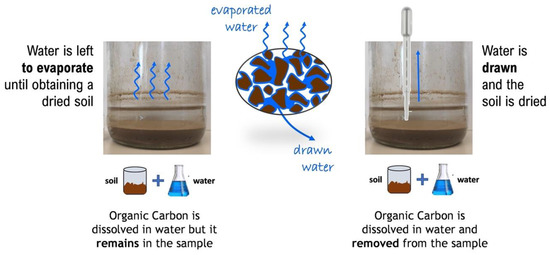
Figure 2.
Sketch of the two different soil wetting treatments to obtain the “evaporated water soil”, Snct-ev or Sdoc-ev, and “drawn water soil”, Snct-dr or Sdoc-dr.
- The soil was suspended in distilled water, which was left to freely evaporate at room temperature until a dried soil was obtained. After one night in an oven at 40 °C, the whole soil sample was gently sieved to 250 μm to break the possible aggregates formed during the previous steps. With this procedure, the whole soil organic carbon remains within the sample, thus mimicking the rainwater infiltration/evaporation process. The soil obtained using this method is referred to as “evaporated water Snct”: Snct-ev or “evaporated water Sdoc”: Sdoc-ev.
- The soil was suspended in distilled water and left to settle. The clear supernatant water was drawn by a syringe, and the resulting viscous and dense paste was then dried at a temperature that never exceeded 40 °C. The whole soil sample was then gently sieved to 250 μm to break the possible aggregates formed during the previous steps. With this procedure, the organic carbon dissolved in the water is drawn together with the supernatant, thus mimicking the rainwater infiltration/drainage process during which the organic carbon in the water is brought away from the soil. The soil obtained using this method is referred to as “drawn water Snct”: Snct-dr or “drawn water Sdoc”: Sdoc-dr.
Notice that Sdoc underwent the two wetting treatments, although already deprived of the DOC fraction and thus not further affectable by wetting treatments, to assess whether secondary alterations of the soil samples occurred during the procedure.
2.2. Methods
2.2.1. Rheology
The slurry samples for the rheological tests were prepared by manually mixing dried soils with bi-distilled water with a solid volume fraction of 40% in all cases. This percentage is similar to what is found in natural slurries during both the initiation stage and the mudflow evolution [27].
Rheological tests were run with a strain-controlled rheometer, ARES G2 (TA Instruments), equipped with a four-blade vane geometry (27.62 mm diameter) rotating within a cup 29.99 mm in diameter. The vane geometry was chosen to minimize wall slip effects in the measurements [28]. The cell was equipped with a solvent trap to avoid water evaporation. The temperature was set at 23 °C and controlled with a Peltier cell with a precision of ±0.1 °C. An accurately designed experimental protocol [21] was used to minimize sedimentation artifacts unavoidably occurring in these systems. The flow curve, viscosity vs. shear rate, was obtained with a sequence of constant shear rate tests of 120 s. Before each step, the sample was first rapidly manually remixed within the cup to re-homogenize the sample, and a pre-shear at 10 s−1 for 15 s was run immediately before the constant shear rate tests. During the constant shear rate, step data evolved over time. The first part of the transients was slightly noisy and was dominated by the microstructural slurry response to the new imposed flow field. The second part was dominated by the occurrence of the unavoidable soil sedimentation which induced a linear reduction of the viscosity over time. To estimate the viscosity at time zero, i.e., unaffected by the sedimentation, the second part of the data was linearly extrapolated to zero.
Tests were repeated at least three times using freshly prepared samples.
2.2.2. Granulometry
We measured the volumetric particle size distribution with the Mastersizer 3000 Laser Diffraction Analyzer (Malvern) equipped with a HydroEv sample dispersion unit, which allowed us to measure the sample granulometry starting from a stirred diluted water dispersion. The instrument can detect particles from 0.01 to 3500 μm.
The soil samples were gently added to the water, which was stirred at a constant velocity of 1500 rpm. In diffractometric measurements, the water suspension must be rather transparent, and a light obscuration percentage of about 10% to 20% is typically considered suitable. In our measurements, all the tests started from the same obscuration of about 15%; to this end, 0.1–0.3 g of soil were typically added to 400 mL of bi-distilled water. As the timing of the experiment was a crucial parameter in these non-conventional tests, the whole loading step lasted exactly 30 s for all the samples. Upon loading, the evolution of the particle size distribution was followed over time for 13.4 min by averaging data recorded each 53 s. During these 53 s, the sample is lit by a red laser for 20 s, and by a blue laser for 30 s; the remaining 3 s were due to instrument internal procedures. The diffraction theory of Mie was used to obtain the particle dimensions. We thus recorded 15 sets of data that described the time evolution under the constant stirring condition of the particle size distribution, as shown in Figure 3 as an example. The stirring flow breaks some larger particles (soil macroaggregates), thus increasing the quantity of smaller ones (soil microaggregates). According to the hierarchical theory of aggregation of soil, the microaggregates form the macroaggregates, thanks to the cohesive forces mainly due to DOC. The evolution of the particle size distribution was thus affected by the amount of DOC effectively binding together the microaggregates.
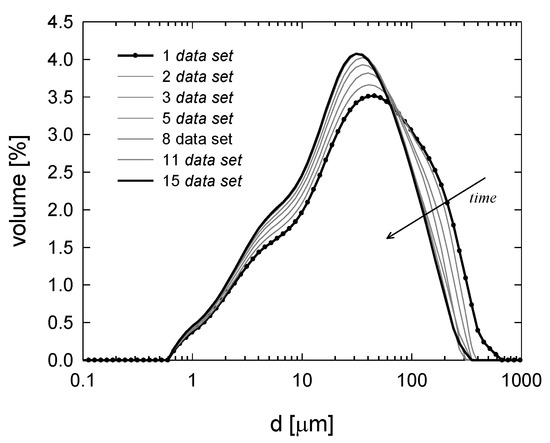
Figure 3.
Example of the evolution over time of the soil particle size distribution under constant stirring conditions.
3. Results
3.1. Rheology
In Figure 4, the flow curves of the different samples are shown. Data are interpolated with a power law function, Equation (1):
where K is the consistency, which represents the viscosity value at shear rate = 1, and n is the flow index, n = 1 indicates a Newtonian behaviour. The best fit parameters are reported in Table 1 together with the coefficient of determination, R2. A clear shear thinning behaviour is observable with a flow index close to 0 for all the samples. This is in agreement with our previous results on slurries made with soils with different content of organic carbon [21]. In the context of a mud flow propagation, the observed marked shear thinning behaviour suggests that, once triggered, mudflow may progressively accelerate.
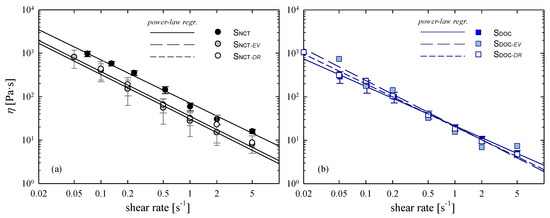
Figure 4.
Flow curves at 23 °C obtained with original, evaporated water and drawn water soil samples for (a) Snct and (b) Sdoc. The error bars are the standard deviation of at least three test repetitions; when not visible, error bars are within the symbols.

Table 1.
Values of the consistency, K, and the flow index, n, obtained with the best fit of Equation (1) through data of Figure 4.
Figure 4b shows that the two water wetting treatments do not influence Sdoc samples. This agrees with the idea that water can only affect the soluble fraction of the organic carbon, which was already removed in Sdoc samples. The three curves in Figure 4b almost overlap, and, indeed, K and n coincide within the experimental uncertainty. This allows us to assess that the wetting treatments do not induce secondary alterations to the soil samples.
Figure 4a shows that both water wetting treatments have a clear and measurable effect on Snct. The viscosity decreases, and the shear thinning behaviour does not change: the consistency is almost halved, and n remains practically zero (Table 1). The flow curves of Snct-dr and Snct-ev slurries lie between the Snct and Sdoc ones, as indicated by the values of the consistencies reported in Table 1. It is interesting to note that the effects of the two water wetting treatments on Snct samples are the same, as the two flow curves of Snct-dr and Snct-ev are superimposed. As a reminder, in the case of the evaporated water soil, the fraction of DOC eventually dissolved remains in the sample, while in the drawn water soil, it is removed from the sample.
3.2. Granulometry
Here we only focus on Snct, Snct-ev, Snct-dr, and Sdoc samples since water wetting treatments do not affect the rheology of Sdoc samples, as shown in Section 3.1.
Figure 5 shows the similar initial volumetric particle size distributions of the four samples. The volumetric average diameters of Snct, Snct-ev, Snct-dr, and Sdoc are very similar: 72, 71.5, 68, and 70 μm, respectively. The four samples have the same minimum (about 0.6 μm) and maximum (about 400 μm) particle diameter. Let us, however, notice that the latter value is slightly larger than the mesh dimension (250 μm) of the used sieve; this is possible because of the irregular shapes of the soil grains. Small differences between the four particle size distributions can be observed in Figure 5; however, they are minor details that cannot explain the differences measured rheologically.

Figure 5.
Initial particle size distribution of the four samples: Snct, Snct-ev, Snct-dr, Sdoc. Error bars are the standard deviations of at least three replicates.
The particle size distributions evolve over time under constant stirring conditions, as already shown in Figure 3. To more effectively highlight the difference between the initial and the final particle size distribution, only these two are plotted in Figure 6 for each soil sample. The smallest evolution is measured for the Snct sample, where only a little reduction of the amount of large macroaggregates is detected. The evolution of the particle size distribution of the Snct-ev, Snct-dr, and Sdoc samples is more pronounced. A clear reduction of larger macroaggregates in favour of smaller ones is now evident. Moreover, the three final distributions appear to be very similar. To further compare the four samples’ behaviour, we plot in Figure 7 the average volumetric diameter DV, also called De Brouckere mean or D4,3, as a function of stirring time. We chose DV as it reflects the size of the particles which constitute the bulk of the sample volume, and it is most sensitive to the presence of large macroaggregates in the particle size distribution. The DV of the Snct sample evolves differently over time from that of the other samples; it only slightly diminishes as the final value is about 81% of the initial one, while that of the others shows a more marked reduction, with a final value of about 67% of the initial one. Most of DV evolution occurs in the first 7 min for all samples; after that, a slower evolution follows until it reaches a steady plateau at about 12 min. Notice that the curves of the two water-treated samples lie in between the curves of Snct and Sdoc, and are very close to the last one. This suggests that the two wetting treatments affect the soil very similarly and lead to a behaviour comparable to that of the Sdoc sample.
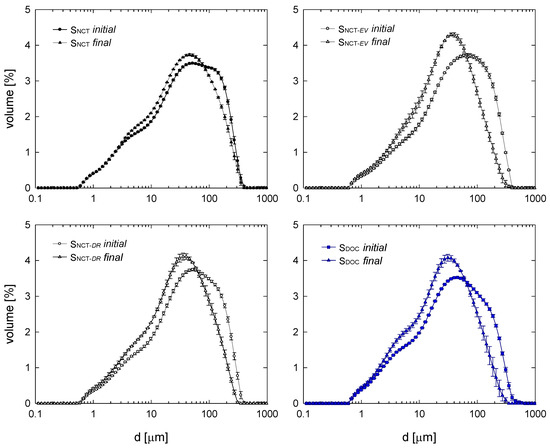
Figure 6.
Initial and final particle size distribution of the four soil samples obtained under constant stirring conditions (1500 rpm) at room temperature. Error bars are the standard deviations of at least three replicates.
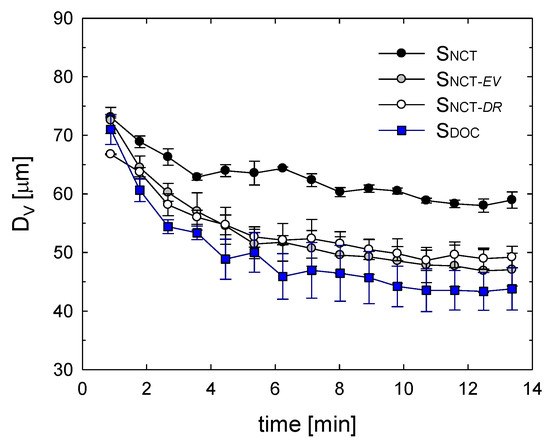
Figure 7.
Volumetric mean diameter of the four soil samples as a function of the stirring time. Error bars are the standard deviation of at least three replicates.
To highlight the breakup of macroaggregates in favour of the formation of smaller aggregates, in Figure 8 we plot the evolution over time of the volume fraction of particles with a large diameter, D [186 μm] Figure 8a, and particles with a small diameter, D [10 μm] Figure 8b. As expected, the former decreases over time, while the latter increases. It is also evident that: (i) the evolution of both volume fractions of the Snct sample is much less pronounced than that of the other three samples; (ii) the curves of Snct-ev and Snct-dr lie in between the curves of Snct and Sdoc samples, and in any case, are closer to the Sdoc curves.
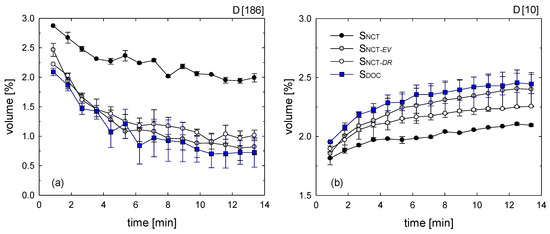
Figure 8.
Time evolution of the volume fraction of particles with diameter of 186 μm (a) and 10 μm (b) to highlight the breakup of large aggregate and the formation of smaller ones.
4. Discussion
The rheological results agree with the granulometric ones in suggesting that the water-wetting-treated soils, Snct-ev and Snct-dr, behave very similarly to the soil without the dissolved organic carbon, Sdoc. In fact, on one hand, the 40% suspensions made with both water-wetting-treated samples show a flow curve practically superimposed on that of the Sdoc suspension. On the other hand, Snct-ev and Snct-dr show an evolution of their particles’ size distribution under constant stirring conditions very similar to that of the Sdoc soil. From these results, we can conclude that the water wetting treatments are able to dissolve, in whole or in part, the soluble soil organic carbon, and it is unessential whether the dissolved organic carbon is brought away from the soil, as in the Snct-dr, or is left in contact with it, as in Snct-ev. This suggests that the stabilizing action of the DOC is exerted only if the organic carbon is still linked to the soil skeleton.
From our results, we can argue that DOC dissolves in water with a characteristic time longer that the experimental duration. Indeed, if this were not the case, the Snct suspensions—concentrated and diluted—should behave identically to the Snct-ev ones, where all the dissolved DOC is not brought away from the sample. We can thus conclude that during the measurements, the Snct samples keep the soluble organic carbon linked to the solid skeleton.
Interestingly, we also underline that we get the same qualitative information by investigating very dilute suspensions with unconventional granulometric measurements and concentrated suspensions with rheological tests. We might then assume that the same qualitative effect is also observable in very concentrated samples, i.e., in the soil covering a natural slope.
Our results suggest that a long enough rainfall can “destabilize” the soil, no matter whether the rainwater infiltrates the soil and percolates downwards, or infiltrates the soil and evaporates. A mud made of this soil will propagate more swiftly and it will very likely be more difficult to stop. Moreover, we may hypothesize that if a long rainfall event capable of dissolving the DOC linked to the soil covering a natural slope is shortly followed by another rainfall event, a mudflow can be more easily triggered, and it can propagate more rapidly. In addition, the organic carbon may affect the capacity of the soil to retain water, especially in conditions close to saturation [29,30]. One of the mechanisms responsible for a landslide trigger is the soil collapse and liquefaction [31] that can thus be affected by the content of the soil organic carbon and its soluble fraction. In view of all these considerations, the destabilizing effect of the dissolution of the organic carbon should be considered as a cofactor determining the mudflow triggering and evolution, and we suggest that the estimations of SOC and DOC content must also be included in the risk assessment analysis.
Finally, the results obtained from the granulometric analysis can give further perspectives in the study of the propagation of landslides where a multiscale approach for granular materials is implemented [32]. Within this framework, the soil grains undergo three interacting mechanisms: segregation, comminution, and mixing. We showed that the rainfall-induced removal of DOC, or a fraction of it, makes the comminution easier, and this could be taken into account in the models mentioned above.
5. Conclusions
For the first time, two different rainwater infiltration mechanisms are mimicked with two wetting treatments to investigate their effect on the destabilization of soil. The destabilization is assessed by studying the rheology of concentrated soil slurry and the evolution of the soil particle size distribution of very diluted suspensions. The different experimental approaches lead us to the same conclusions.
The use of granulometry, along with the unconventional experiments developed in this work, is a new and rapid technique to investigate soil stability.
The wetting treatments mimic the rainwater infiltration/evaporation mechanisms and the infiltration/percolation ones. In the first case, the DOC is dissolved, and it remains within the sample. In the second case, it is dissolved, and it is brought away from the sample. The two typologies of samples behave identically in our tests, thus allowing us to conclude that soil destabilization occurs when the organic carbon is “detached” from the solid grains.
Author Contributions
Conceptualization, C.C. and M.M.; methodology, C.C. and M.M.; data curation, C.C.; writing—original draft preparation, C.C. and M.M.; writing—review and editing, C.C. and M.M.; funding acquisition, M.M. All authors have read and agreed to the published version of the manuscript.
Funding
This research was funded by the University of Campania Luigi Vanvitelli under the programme “V:ALERE: VAnviteLli pEr la RicErca” project: SEND.
Data Availability Statement
Data are available from the corresponding authors upon request.
Acknowledgments
Raffaella Martone is acknowledged for the help provided in the experiments.
Conflicts of Interest
The authors declare no conflict of interest. The funders had no role in the design of the study; in the collection, analyses, or interpretation of data; in the writing of the manuscript; or in the decision to publish the results.
References
- De Blasio, F.V.; Breien, H.; Elverhøi, A. Modelling a cohesive-frictional debris flow: An experimental, theoretical, and field-based study. Earth Surf. Process. Landf. 2011, 36, 753–766. [Google Scholar] [CrossRef]
- Lorenzini, G.; Mazza, N. Debris Flow: Phenomenology and Rheological Modelling; WIT Press: Southampton, UK, 2004. [Google Scholar]
- Greco, R.; Guida, A.; Damiano, E.; Olivares, L. Soil water content and suction monitoring in model slopes for shallow flowslides early warning applications. Phys. Chem. Earth Parts A/B/C 2010, 35, 127–136. [Google Scholar] [CrossRef]
- Iverson, R.M.; Logan, M.; LaHusen, R.G.; Berti, M. The perfect debris flow? Aggregated results from 28 large-scale experiments. J. Geophys. Res. Earth Surf. 2010, 115, F03005. [Google Scholar] [CrossRef]
- Tozato, K.; Dolojan, N.L.J.; Touge, Y.; Kure, S.; Moriguchi, S.; Kawagoe, S.; Kazama, S.; Terada, K. Limit equilibrium method-based 3D slope stability analysis for wide area considering influence of rainfall. Eng. Geol. 2022, 308, 106808. [Google Scholar] [CrossRef]
- Placido Antonio Gatto, M.; Montrasio, L. X-SLIP: A SLIP-based multi-approach algorithm to predict the spatial–temporal triggering of rainfall-induced shallow landslides over large areas. Comput. Geotech. 2023, 154, 105175. [Google Scholar] [CrossRef]
- Greco, R.; Giorgio, M.; Capparelli, G.; Versace, P. Early warning of rainfall-induced landslides based on empirical mobility function predictor. Eng. Geol. 2013, 153, 68–79. [Google Scholar] [CrossRef]
- Shano, L.; Raghuvanshi, T.K.; Meten, M. Landslide susceptibility evaluation and hazard zonation techniques—A review. Geoenviron. Disasters 2020, 7, 18. [Google Scholar] [CrossRef]
- Zhang, Y.; Zhang, J.; Dong, L. Fuzzy Logic Regional Landslide Susceptibility Multi-Field Information Map Representation Analysis Method Constrained by Spatial Characteristics of Mining Factors in Mining Areas. Processes 2023, 11, 985. [Google Scholar] [CrossRef]
- Greco, R.; Comegna, L.; Damiano, E.; Marino, P.; Olivares, L.; Santonastaso, G.F. Recurrent rainfall-induced landslides on the slopes with pyroclastic cover of Partenio Mountains (Campania, Italy): Comparison of 1999 and 2019 events. Eng. Geol. 2021, 288, 106160. [Google Scholar] [CrossRef]
- Holthusen, D.; Batistão, A.C.; Reichert, J.M. Amplitude sweep tests to comprehensively characterize soil micromechanics: Brittle and elastic interparticle bonds and their interference with major soil aggregation factors organic matter and water content. Rheol. Acta 2020, 59, 545–563. [Google Scholar] [CrossRef]
- Yuan, J.; Ye, L.; Hu, G.; Fang, Y.-G. Experimental Study on the Influence of Granulometric and Material Compositions on Soil Rheological Properties. Soil Mech. Found. Eng. 2020, 57, 35–42. [Google Scholar] [CrossRef]
- Zander, F.; Shakeel, A.; Kirichek, A.; Chassagne, C.; Gebert, J. Effects of organic matter degradation in cohesive sediment: Linking sediment rheology to spatio-temporal patterns of organic matter degradability. J. Soils Sediments 2022, 22, 2873–2882. [Google Scholar] [CrossRef]
- Geoghegan, M.J.; Brian, R.C. Aggregate formation in soil. 2. Influence of various carbohydrates and proteins on aggregation of soil particles. Biochem. J. 1948, 43, 14. [Google Scholar] [CrossRef] [PubMed]
- Haynes, R.J.; Swift, R.S. Stability of soil aggregates in relation to organic constituents and soil water content. J. Soil Sci. 1990, 41, 73–83. [Google Scholar] [CrossRef]
- Bronick, C.J.; Lal, R. Soil structure and management: A review. Geoderma 2005, 124, 3–22. [Google Scholar] [CrossRef]
- Six, J.; Bossuyt, H.; Degryze, S.; Denef, K. A history of research on the link between (micro)aggregates, soil biota, and soil organic matter dynamics. Soil Tillage Res. 2004, 79, 7–31. [Google Scholar] [CrossRef]
- Chantigny, M.H. Dissolved and water-extractable organic matter in soils: A review on the influence of land use and management practices. Geoderma 2003, 113, 357–380. [Google Scholar] [CrossRef]
- Liang, K.; Li, T.; He, B.; Qian, T. Dynamics of dissolved organic carbon in runoff discharge under different rainfall patterns in a representative agricultural catchment. J. Hydrol. 2023, 617, 129079. [Google Scholar] [CrossRef]
- Komolvilas, V.; Kikumoto, M.; Kyokawa, H. Mechanism of wetting–induced deformation and failure of unsaturated soils. Int. J. Numer. Anal. Methods Geomech. 2022, 46, 1064–1092. [Google Scholar] [CrossRef]
- Carotenuto, C.; Merola, M.C.; Álvarez-Romero, M.; Coppola, E.; Minale, M. Rheology of natural slurries involved in a rapid mudflow with different soil organic carbon content. Colloids Surf. A 2015, 466, 57–65. [Google Scholar] [CrossRef]
- Kalbitz, K.; Angers, D.A.; Kaiser, K.; Chantigny, M.H. Extraction and Characterization of Dissolved Organic Matter; CRC Press: Boca Raton, FL, USA, 2007. [Google Scholar]
- Zimmermann, M.; Leifeld, J.; Abiven, S.; Schmidt, M.W.I.; Fuhrer, J. Sodium hypochlorite separates an older soil organic matter fraction than acid hydrolysis. Geoderma 2007, 139, 171–179. [Google Scholar] [CrossRef]
- Carotenuto, C.; Minale, M. Effect of the Soil Organic Content on Slurries Involved in Mudflows. Prog. Earth Planet. Sci. 2016, 16, 89–97. [Google Scholar] [CrossRef]
- Picarelli, L.; Olivares, L.; Comegna, L.; Damiano, E. Mechanical Aspects of Flow-Like Movements in Granular and Fine Grained Soils. Rock Mech. Rock Eng. 2008, 41, 179–197. [Google Scholar] [CrossRef]
- Coussot, P. Rheometry of Pastes, Suspensions, and Granular Materials: Applications in Industry and Environment; John Wiley & Sons: Hoboken, NJ, USA, 2005. [Google Scholar]
- Coussot, P.; Laigle, D.; Arattano, M.; Deganutti, A.; Marchi, L. Direct Determination of Rheological Characteristics of Debris Flow. J. Hydraul. Eng. 1998, 124, 865–868. [Google Scholar] [CrossRef]
- Minale, M. Modelling the flow of a second order fluid through and over a porous medium using the volume averages. II. The stress boundary condition. Phys. Fluids 2016, 28, 023103. [Google Scholar] [CrossRef]
- Lal, R. Soil organic matter and water retention. Agron. J. 2020, 112, 3265–3277. [Google Scholar] [CrossRef]
- Rawls, W.J.; Pachepsky, Y.A.; Ritchie, J.C.; Sobecki, T.M.; Bloodworth, H. Effect of soil organic carbon on soil water retention. Geoderma 2003, 116, 61–76. [Google Scholar] [CrossRef]
- Airey, D.W.; Ghorbani, J. Analysis of unsaturated soil columns with application to bulk cargo liquefaction in ships. Comput. Geotech. 2021, 140, 104402. [Google Scholar] [CrossRef]
- Marks, B.; Einav, I. A heterarchical multiscale model for granular materials with evolving grainsize distribution. Granul. Matter 2017, 19, 61. [Google Scholar] [CrossRef]
Disclaimer/Publisher’s Note: The statements, opinions and data contained in all publications are solely those of the individual author(s) and contributor(s) and not of MDPI and/or the editor(s). MDPI and/or the editor(s) disclaim responsibility for any injury to people or property resulting from any ideas, methods, instructions or products referred to in the content. |
© 2023 by the authors. Licensee MDPI, Basel, Switzerland. This article is an open access article distributed under the terms and conditions of the Creative Commons Attribution (CC BY) license (https://creativecommons.org/licenses/by/4.0/).